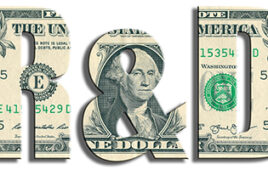Enter the 2019 R&D 100 Awards!
The Dow BETAFORCE 9050M composite bonding adhesives for automotive mass production was a 2018 R&D 100 Award winner. All of the R&D 100 Awardees were announced at the R&D 100 Awards Gala held in Orlando, Florida on Nov. 16, 2018.
The R&D 100 Awards have served as the most prestigious innovation awards program for the past 57 years, honoring R&D pioneers and their revolutionary ideas in science and technology.
Submissions for the 2019 R&D 100 Awards are now being accepted. Any new technical product or process that was first available for purchase or licensing between January 1, 2018 and March 31, 2019, is eligible for entry in the 2019 awards.
Start or complete your entry now: visit: https://rd1002019.secure-platform.com/a For more info: www.rd100conference.com/awards
The body of new lightweight multi-material vehicle bodies are generally produced from a combination of steel, aluminum and magnesium on a carbon fiber composite rear panel that is bonded into the car body.
However, for this type of design to work, a two-component polyurethane adhesive is needed to keep everything in place during the manufacturing process and for the duration of the life of the vehicle.
BETAFORCE 9050M composite bonding adhesives for automotive mass production, developed by DuPont Transportation & Advanced Polymers, a DowDuPont Specialty Products Division Business, could help solve this problem, by minimizing body weight without sacrificing strength or durability. The innovation was a 2018 R&D 100 Award winner.
The adhesive enables improved stiffness of vehicle body design by using a higher modulus adhesive technology and a stiffer carbon fiber composite and results in improved environmental resistance compared to other design solutions and significantly reduced cycle times.
Andreas Lutz, PhD, the R&D Director for Automotive Adhesives for DuPont Transportation & Advanced Polymers, explained in an exclusive interview with R&D Magazine that adhesives like BETAFORCE are needed to bond the composites to coated metals to make vehicles.
“Composites are not spot weldable so you cannot apply any thermal joining methods,” Lutz said. “Riveting is also an issue because you can damage the fiber in the composites. That’s why adhesives are the joining method you choose for that application because you want to keep the integrity of the fiber composite part and not damage it.
“It combines excellent adhesion not only to composites but also to any kind of coated metal,” he added. “It comes with the ability to modify any kind of modulus and even at higher modulus it achieves excellent energy absorption. Our adhesives are curing well at room temperature but also can be very well heat accelerated and we don’t need any activation of the surface by adding a solvent-based activator or a solvent-based primer.”
For the adhesive to properly work, it needs to operate in a way that exhibits ambient temperature latency, while maintaining adhesions performance through assembly time and maximizing the time of which the mixed adhesive is allowed to remain in a mixer units without creating the need to purge. The adhesive also must stay soft to accommodate mechanical fixation, added less than an hour after the adhesive is applied.
Shear strength values of between approximately one and three MPa are reached at adhesive temperature of greater 65 degrees Celsius, guaranteeing that add-on parts and the entire rear panel are kept in position and that potential stresses in the bond line due to the bond gap and part geometry fluctuations or manufacturing processes can be compensated.
The technology operates in a way that the stiffness of the bonded joints is independent from the ambient temperature and humidity, enabling driving comfort based on vehicle stiffness, independent from the ambient climate.
The material also allows for high flow rates and fast application, as well as an efficient mixing of the two components in static and dynamic mixers necessary to reach end cure properties and obtain desired curing kinetics.
Lutz explained how industry desires led to the advent of BETAFORCE.
“It was always driven by the lightweight initiative by our customers to reduce body weights of vehicles,” he said. “They were looking for options how to significantly reduce the bodyweight of vehicles besides using metals, like the lightweight metals. It all started with brainstorming for finding an adequate chemical joining method to join composites to metal or composite-to-composite. Then we developed these products in collaboration with our customers.”

Figure 1. Close up of an add-on bonded part on the carbon fiber Audi A8 rear wall: e-coated metal parts bonded with BETAFORCE 9050M to carbon fiber re-enforced plastics in a heat accelerated process. Credit: Dow
Lutz said that in recent years the automotive industry began using lightweight, higher grade steel or steel and aluminum combinations to reduce the bodyweight of vehicles. However, with major advancements achieved in that portion of the vehicle, manufacturers began looking at other ways to reduce the vehicle weight.
According to Lutz, composites are becoming a particularly important material for vehicles as governments began tightening regulations in an effort to reduce fuel emissions.
While the focus on the adhesive has been in the automotive industry, Lutz said it can be leveraged in other fields, including wind turbines and the composites commonly used to make aircrafts.




